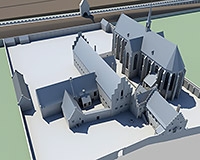PhD project
The history of the possessions of the “Teutonic House” and the bailiwick of Utrecht, 1231-1619
The acquisition and administration of the possessions of the “Teutonic House” in Utrecht, and its dependencies, in the Middle Ages until c.1600.
- Duration
- 2014 - 2018
- Funding
- Ridderlijke Duitsche Orde, Bailiwick of Utrecht
The Teutonic House (“Duitse Huis”) in Utrecht was a regional center of the Teutonic Order, one of the main three military orders (the other two are the Templars and the Hospitallers). These orders appeared during the crusades and operated mainly in the Holy Land and on the borders of Christendom elsewhere. In due time, the Teutonic Order came to possess dozens of castles in Prussia and the Baltic. However, from its foundation in 1191 the Order also acquired large complexes of landed property and founded many establishments in Western Europe. Their purpose was to organize the recruitment of new members and to collect money for financing the fight in the East. This study aims to analyze the material organization of one of such Western establishments. The aim is to gain more insight into the functioning of the Order and its public support and to get a better understanding of the social and economic development of monastic institutions in the Northern Netherlands in general.
The history of the possessions of the “Teutonic House” in Utrecht

Introduction
This research project aims to analyze the formation and administration of the material possessions of the “Teutonic House” (Duitse Huis) in Utrecht from its foundation in the early 13 th century until about 1600.
In 1231 Sweder van Dingede and his wife Beatrix donated a house and homestead close to the St. Geerte church in Utrecht to the Teutonic Order. Soon the convent founded there would become the headquarter of this big military order in the diocese of Utrecht. In the late Middle Ages its district (=bailiwick) counted fifteen subordinate establishments. Therewith it was a medium-sized bailiwick within the Teutonic Order. The history of the Utrecht bailiwick continues until the present day. Unlike other bailiwicks, it has stood the test of time. It survived major turning points in history, like the 16 th-century Reformation or its formal dissolution by Napoleon in 1810. Its transformation into a Protestant noble-charitable organization contributed largely to this continuation. As a result, many of its possessions that were obtained before 1500 still belong to the present Bailiwick of Utrecht of the Teutonic Order.
Research needed
Furthermore, a relatively large amount of medieval sources about the acquisition and administration of the possessions have been preserved. This makes a thorough study about this subject possible. Recently, with the support of the Teutonic House and the University of Groningen, Menno Koopstra extracted large amounts of data from these sources into datasets that are accessible for future research. However, the material situation of the Teutonic House is still surrounded by question marks. Recent publications of Mol, Meuwissen, de Bruin, and Stapel have added to the need of finding answers on this subject. For example, many cultural and political research questions cannot be answered without sufficient knowledge of the economic situation of the Utrecht bailiwick. Moreover, international researchers in the field of military orders and the crusades are emphasizing for quite a long time that the rich archives of the Teutonic House can be compared to other bailiwicks that have been studied before and place them into perspective. Such a study would also be of great importance for further research into the social-economic history of the Northern Netherlands in the Late Middle Ages. Especially for the episcopal province of Utrecht, but also in the case of Gelre and Holland there is a need for monographs about religious institutions as large landowners with a great amount of continuity. Last but not least, the current Teutonic House can benefit from this study by gaining knowledge about the formation of their possessions, how it was administered in the Middle Ages, and how this knowledge can contribute to a responsible administration of its possessions today.
Research question and research goals
This study aims to analyze the material organization of the Teutonic House (“Duitse Huis”) in Utrecht from its formation about 1230 until it transformed into a protestant organization about 1600. This needs to be explained and compared in relation to the social and religious functions of the Teutonic House, the bailiwick, the social background of its members, and the leading capacities of its superiors. A first quick scan revealed an economic development that was not only heavily influenced by general economic and religious conjunctures, but also by the ambitions and capabilities of its superiors, called the land commander. Therefore, one of the questions is how influential this personal factor was. The aim is twofold: To gain more insight into the functioning of the Order and its public support, and to get a better understanding of the social and economic development of monastic institutions in the Northern Netherlands in general.
